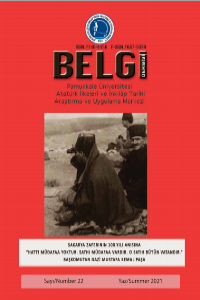CUMHURİYETİN İLK DÖNEMİNDE GELENEKSEL BİR ÜRÜN: KASTAMONU KENDİRİNİN (KENEVİR) TARİHSEL GELİŞİMİ (1923-1950)
Abstract
Kendir, lif bitkileri, endüstri bitkileri ve tıbbi aromatik bitkileri gurubundadır. Kastamonu, Cumhuriyetin ilk yıllarında Türkiye’de en çok kendir üretimin olduğu ildir. Kastamonu ilinin coğrafi şartları kendir üretimi için oldukça uygundur. Ancak, 1950 yılına kadar Kastamonu’da kendirin ekiminden hasadına ve işlenmesine kadar oldukça iptidai bir üretim tarzı vardı. Kastamonu’daki tarımın ilkel ve geleneksel özelliklerinden dolayı kendir üretim potansiyeli düşük düzeydi. Kastamonu’da kendir küçük aile işletmeleri tarafından hane halkının ortak emeği ile üretilen bir tarım ürünüdür. Ancak bu ürün geleneksel köy sanatı olmaktan ve el dokuma tezgahlarında dokunmaktan öte gidememiştir. Bu yüzden kendir katma değerli bir üretimden mahrum kalmıştır. Kastamonu’da üretilen kendirin pazar yeri Kastamonu, Germeç ve Taşköprü’dür. Kastamonu kendir lifi çok kaliteliydi ancak, bölge halkının yetersiz sermayesi ve nakliyat sıkıntıları bulunmaktaydı. Bu durum kendir üretiminin ve kendirin işlenmesinin modern tekniklerle yapılmasını engellemiştir. Taşköprü Kendir Sanayi devletçilik politikaları kapsamında kendir ürünlerinin üretimi açısından önemli bir girişimcilik olsa da fabrika uzun ömürlü olmamıştır. Hatta bu çalışma Kastamonu ilindeki kendir tarımı özelinde ve kendirin endüstrileşme sürecinde Türkiye’nin siyasi, iktisadi ve toplumsal yapısını da göstermektedir. Bir diğer ifade ile, bu çalışma 1930’larda Türkiye’nin kırsal alanlarını, toplumu ve sanayileşme dinamiklerini incelemektedir. Ancak bu çalışma Hint Kenevirini ele almadığı için bu çalışmada esrar kullanımı veya uyuşturucu bağımlığı hakkında bilgi yoktur.
Keywords
References
- Bozkurt, Hıdır (2019), Türkiye Cumhuriyeti-SSCB Ticari İlişkiler (1923-1938), Ege Üniversitesi Sosyal Bilimler Enstitüsü, İzmir.
A TRADITIONAL CROP IN THE EARLY REPUBLICAN PERIOD: A SOCIAL HISTORY OF KASTAMONU CANNABIS (1923-1950)
Abstract
Cannabis is in the groups of fiber plants, cash crops and medicinal -aromatic plants. Kastamonu is the province where there had been the highest levels of cannabis production in the first years of the Republic of Turkey. The geographical conditions of Kastamonu are quite suitable for cannabis production. However, from the cultivation of cannabis to the harvest, and processing of cannabis, there had been quite primarily modes of production until 1950. Due to the primary and traditional characteristics of the agriculture in Kastamonu, cannabis production capacity was at low level. Cannabis was an agricultural product that had been produced by small sized family business through the common labor of household. However, the crop could not be more than traditional village art and having been weaved in hand loom. Thus, cannabis lacked a value-added production. The marketplaces of the cannabis produced in Kastamonu are Kastamonu, Germeç, and Taşköprü. The hemp fiber of Kastamonu was very qualified, but there had been an insufficient capital of the local people and transportation problems. This situation prevented the production and the processing of cannabis by means of modern techniques. Although Taşköprü Cannabis Industry was an important enterprise within the scope of statism to produce hemp products, the industry could not be long lived. Furthermore, this study indicates the political, economic, and social structure of Turkey specific to the cannabis farming, and the industrialization process of cannabis in Kastamonu province. In other words, this study examines the rural areas, the society, and the industrialization dynamics of Turkey in the 1930s. However, since this study does not deal with cannabis Indica, there is not further information about the use of marijuana or drug addiction.
References
- Bozkurt, Hıdır (2019), Türkiye Cumhuriyeti-SSCB Ticari İlişkiler (1923-1938), Ege Üniversitesi Sosyal Bilimler Enstitüsü, İzmir.
Details
| Primary Language | Turkish |
|---|---|
| Journal Section | Research Article |
| Authors | |
| Publication Date | July 1, 2021 |
| Submission Date | February 24, 2021 |
| Acceptance Date | March 24, 2021 |
| Published in Issue | Year 2021 Issue: 22 |


